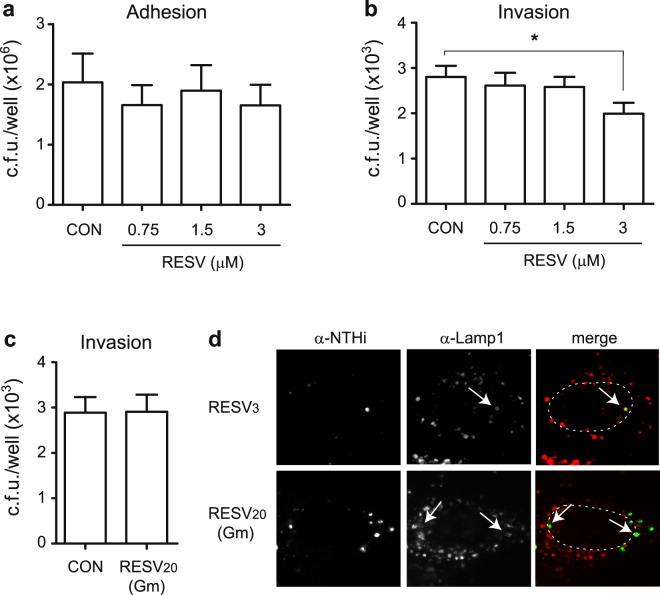Figure 2.
A resveratrol sub-inhibitory concentration lowers NTHi375 invasion of A549 human respiratory epithelial cells. Controls (CON): in adhesion and invasion assays (a and b, respectively), cells did not receive resveratrol (RESV), but did receive vehicle solution (DMSO) prior and during bacterial contact; in invasion assay (c), cells received vehicle solution during gentamicin treatment. Effect of resveratrol sub-inhibitory concentrations on NTHi375 adhesion to- (a) and invasion of (b) A549 cells. Cells were pre-treated with resveratrol 0.75, 1.5, or 3 μM for 4 h, and the polyphenol was maintained during infection. Bacterial adhesion was comparable for resveratrol-treated and control (CON) cells. Mean numbers of NTHi375 entry into cells treated with resveratrol 3 μM were significantly lower than those obtained for control (CON) cells (p < 0.05). (c) Resveratrol effect on intracellular NTHi375. A549 cells were infected and resveratrol 20 μM was added during cell incubation with gentamicin (Gm). Resveratrol did not reduce the number of intracellular bacteria. (d) Subcellular location of NTHi375 inside A549 cells shows co-localization with Lamp-1 endosomal marker. NTHi was stained with rabbit α-NTHi and Alexa 488-conjugated donkey α-rabbit (green) antibodies. Lamp-1 was stained with mouse α-Lamp-1 and donkey α-mouse conjugated to RRX (red) antibodies. A549 cells were pre-treated with resveratrol 3 μM for 4 h, which was maintained during infection (upper panels); alternatively, A549 cells were infected for 2 h and resveratrol 20 μM was added during cell incubation with Gm (lower panels). Representative images are shown, taken at 1 h post-Gm. Host cell nuclei location is indicated with dashed lines. Bacteria:Lamp-1 co-localization is indicated with arrows.

